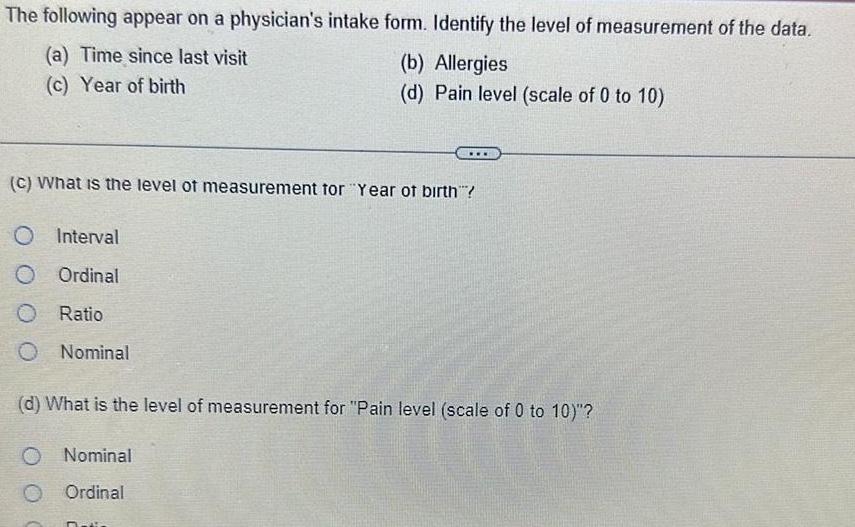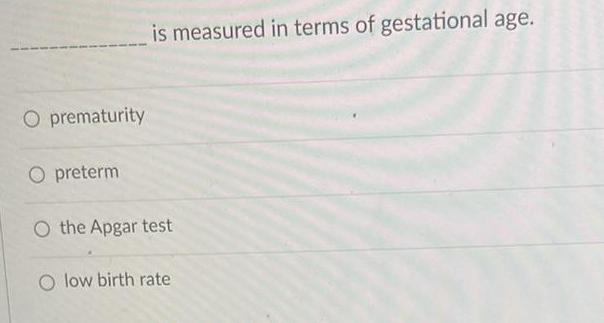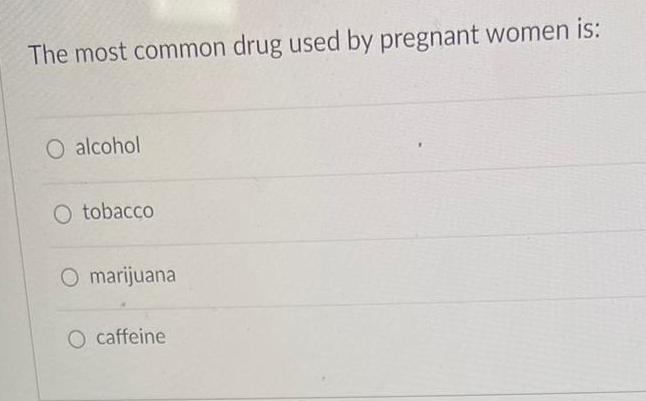Introduction to Physiology Questions and Answers

Anatomy and Physiology
Introduction to PhysiologyThe Eustachian tubes open into the O a laryngopharynx O b nasal cavity O c larynx O d nasopharynx O e oropharynx

Anatomy and Physiology
Introduction to PhysiologyThe epicardium O a is the pacemaker of the heart O b lines the heart chambers O c is also known as the parietal pericardium O d is the visceral pericardium O e is a layer of cardiac muscle

Anatomy and Physiology
Introduction to PhysiologyThe principal respiratory centers that directly control breathing are located in the O a lung and medulla oblongata O b cerebrum and hypothalamus O c medulla oblongata and pons O d hypothalamus and cerebrum

Anatomy and Physiology
Introduction to PhysiologyChoose the correct sequence of current flow electrical signal through the heart wall O a SA node Purkinje fibers AV node AV bundle of His right and left bundle branches O b AV node Purkinje fibers AV node AV bundle of His right and left bundle branches O c SA node AV node AV bundle of His right and left bundle branches Purkinje fibers O d AV node SA node Purkinje fibers AV bundle of His right and left bundle branches

Anatomy and Physiology
Introduction to PhysiologyThe term vasoconstriction refers to O a delivering oxygen and nutrients to the body tissues O b increasing the size of the lumen of the blood vessel O c decreasing the size of the lumen of the blood vessel delivering waste products to the kidney for excretion O d

Anatomy and Physiology
Introduction to PhysiologyWhat separates the lungs from the thoracic cavity O a skeletal muscle O b pleura O c bone O d alveoli

Anatomy and Physiology
Introduction to PhysiologyA blockage in the external iliac artery will reduce blood flow to the O a external iliac artery O b common iliac artery O c abdominal aorta O d femoral artery

Anatomy and Physiology
Introduction to PhysiologyWhich of the following opposes the flow of blood back to the heart O a blood pressure O b muscular pumps squeeze veins and move blood toward the heart O c peripheral veins have valves to prevent backflow of blood O d vascular resistance O e blood pressure gradient from arteries to veins

Anatomy and Physiology
Introduction to PhysiologyThe following appear on a physician s intake form Identify the level of measurement of the data a Time since last visit c Year of birth Interval Ordinal O Ratio O Nominal b Allergies d Pain level scale of 0 to 10 C What is the level of measurement for Year of birth O Nominal O Ordinal d What is the level of measurement for Pain level scale of 0 to 10

Anatomy and Physiology
Introduction to PhysiologyO prematurity O preterm is measured in terms of gestational age O the Apgar test low birth rate

Anatomy and Physiology
Introduction to PhysiologyThe most common drug used by pregnant women is O alcohol O tobacco O marijuana O caffeine

Anatomy and Physiology
Introduction to PhysiologyThe highest international percentage of c sections performed annually at 58 percent occurs in Japan the United States O the Dominican Republic Brazil

Anatomy and Physiology
Introduction to PhysiologyIn a first birth the average length of active labor is O4 hours 7 hours 14 hours 24 hours

Anatomy and Physiology
Introduction to PhysiologyBased on these agglutination results what is the blood type Anti A Anti B Anti D

Anatomy and Physiology
Introduction to PhysiologyWhich of the statements is incorrect 1 Patients with Duchenne muscular dystrophy usually die in their 60s II Sleep is not affected in patients with fibromyalgia III Cerebral palsy is caused by lesions on or damage to the brain O Only I Only II Only III OI II and III

Anatomy and Physiology
Introduction to PhysiologySpending time in the sun each day can improve humans health Sunlight helps fight certain conditions from osteoporosis weak bones and cancer to depression and heart attacks Strong Source Information and a Strong Reporting Verb Weak Source Information A Weak Reporting Verb No Source Information or Reporting Verb

Anatomy and Physiology
Introduction to PhysiologyWhat was the War Production Board s purpose all of these to enforce trade agreements with non warring nations to ensure that all countries followed the rules of engagement and that civilians were not harmed during the to oversee and control the US total war effort during WWII

Anatomy and Physiology
Introduction to PhysiologyWhy did the US ultimately decide to drop atomic bombs on Hiroshima and Nagasaki the US was concerned that they would not get to use the bombs in the future if they did not use them during WW2 the US thought that using atomic bombs would encourage Germany to surrender more quickly avoiding a land invasion of Japan would save numerous Allied forces lives the US did not have enough air power to attack Japan successfully

Anatomy and Physiology
Introduction to PhysiologyWhich example highlights the impact of the Lend Lease Act it allowed the Germans to transfer money to secret accounts in the US to avoid paying penalties for World War 1 it encouraged wealthy landowners in the west to lease their land to the poor so that they could have employment in agricultu it overruled cash and carry enabling the US to loan weapons and supplies to countries vital to the defense of the US it was the first formal step in declaring war on Japan after the attack at Pearl Harbor

Anatomy and Physiology
Introduction to PhysiologyWhich example displays a challenge the US faced on the Pacific front of WWII all of these difficulty transporting weapons to troops due to limited infrastructure in Pacific difficulty preserving food for troops due to harsh climate leading to spoiled food difficulty getting medical supplies to troops because distance to Pacific was 3 times distance from New York to Great B

Anatomy and Physiology
Introduction to Physiologyevents which theorist Karl Marx or Max Weber offered the most realistic interpretation of capitalism In other words whose ideas about capitalism were the most correct Karl Marx or Max Weber What do these theorists say about capitalism In your opinion what do these two theorists get right In your opinion what do these two theorists get wrong Correctly discuss Karl Marx s and Max Weber s ideas about capitalism and bureaucracy Your paper should discuss and correctly summarize the ideas of Marx and Weber The argument of the paper should discuss whose perspective you see as offering the most correct ideas about capitalism Do not include quotes in the paper Instead

Anatomy and Physiology
Introduction to PhysiologyWhich of the following is closest to Ackerman s overall argument O Physicians should prioritize nonmaleficence over patient autonomy O Physician noninterference does not always respect patient autonomy because of how illness changes patients O Respecting patient autonomy generally requires noninterference because patients need to be left alone to make their own decisions

Anatomy and Physiology
Introduction to PhysiologyWhich of the following arguments does NOT appeal to autonomy O Even if it would cause upset the patient ought to be told if their illness is terminal After all each patient has the right to know the truth so they can determine how they want to handle their impending death O Making a trans patient wait years to access transition related care will cause that patient to suffer ongoing serious distress It is wrong to let that happen O Simply giving a patient a form to sign is not sufficient for truly informed consent Informed consent requires medical providers to make sure that patients are in a good position to guide their treatment rather than simply handing over real control to others

Anatomy and Physiology
Introduction to Physiology23 Explain what happens to erythrocytes after they become old and break hint what happens to hemoglobin after erythrocytes are broken down

Anatomy and Physiology
Introduction to Physiology17 Type B blood carries B antibodies and B antigens A antibodies and B antigens B antibodies and A antigens d None of the above a b c 18 Type AB blood carries a A antibodies B antibodies no antigens b A antigens B antigens no antibodies c A antibodies B antibodies A antigens B antigens d None of the above 19 Type O blood carries a A antibodies b antibodies no antigens b No antibodies A antigens B antigens c No antibodies no antigens d None of the above

Anatomy and Physiology
Introduction to Physiology16 Type A blood carries b a A antibodies and A antigens A antibodies and B antigens B antibodies and A antigens d None of the above C

Anatomy and Physiology
Introduction to PhysiologyPermitting the exchange of nutrients and gases between the blood and tissue cells is the primary function of O a Veins Ob Arteries O c Capillaries O d Arterioles

Anatomy and Physiology
Introduction to PhysiologyWhich of the following receives only sympathetic innervation O a Kidney O b O c Heart O d Liver Intestines

Anatomy and Physiology
Introduction to PhysiologyAll of the following can affect pulmonary ventilation except O a Airway Resistance b The oxygen hemoglobin dissociation curve Oc Compliance of the Lungs Od Surface Tension of Alveolar Fluid

Anatomy and Physiology
Introduction to PhysiologyPolycythemia decreases the viscosity of blood thus increasing blood pressure O a True Ob False

Anatomy and Physiology
Introduction to PhysiologyBranching is found in O a Cardiac muscle O b Skeletal muscle O c None of the answers is correct Od Smooth muscle

Anatomy and Physiology
Introduction to PhysiologyConsidering action potential which of the following is correct Threshold stimulus is required O b K goes from ECF to ICF Does not obey all or none phenomenon d It is a gradual phenomenon

Anatomy and Physiology
Introduction to PhysiologyWhich of the following depolarizes next after the AV node O a Bundle of His O b SA node O c Right and left bundle branches O d Purkinje fibers

Anatomy and Physiology
Introduction to PhysiologyBlood is slowest in the capillaries as results of Smallest total cross sectional area Ob Largest total cross sectional area Smallest blood vessels diameter C Od Largest blood vessels diameter

Anatomy and Physiology
Introduction to PhysiologyNot yet answered Marked out of 1 00 The heart s natural pacemaker is termed the a Atrioventricular node b Bundle of His atrioventricular bundle c Purkinje fibers d Sinoatrial node

Anatomy and Physiology
Introduction to PhysiologyLocated between the right atrium and right ventricle is the O a Aortic semilunar valve O b Bicuspid mitral atrioventricular valve O c Pulmonary semilunar valve Od Tricuspid atrioventricular valve

Anatomy and Physiology
Introduction to PhysiologyWhich law discusses the statement The total pressure of a mixture of gases is the sum of the individual partial pressures of gases in that mixture O a Boyle s law O b Henry s law O C Charles law O d Dalton s law

Anatomy and Physiology
Introduction to PhysiologyHighest blood vessels resistance can be detected in O a Arteries O b Vena cava c Veins d Arterioles OC

Anatomy and Physiology
Introduction to PhysiologyMultinucleated and periphrelly located nuclei are O a Skeletal muscle O b Smooth muscle None of the answers is correct O d Cardiac muscle

Anatomy and Physiology
Introduction to PhysiologyObese people often have hypertension because of O a All answers are correct O b Adipose tissue increases pressure on blood vessels Oc Additional blood vessels in adipose tissue O d Adipose tissue increases heart rate and cardiac output

Anatomy and Physiology
Introduction to PhysiologyIf systolic pressure was 150 mmHg and diastolic pressure was 90 mmHg mean arterial pressure will be equal to O a 110 mmHg O b 120 mmHg O c 100 mmHg O d 90 mmHg

Anatomy and Physiology
Introduction to PhysiologyThe period of time during which a second action potential can be initiated but only by a larger than normal stimulus is O a Relative refractory period O b Inhibitory postsynaptic period O c Absolute refractory period Od Excitatory postsynaptic period

Anatomy and Physiology
Introduction to PhysiologyHigh lung compliance means O b O a Lung is filled with blood and resist expansion Lungs and chest wall resist expansion O c Lungs and chest wall expand easily Od Lung is filled with fluid and expand easily

Anatomy and Physiology
Introduction to PhysiologyAnticholinesterase is used to treat O a None of the answers is correct O b Muscle spasm O c Extend the effects of curare like drugs after surger Od Myasthenia gravis

Anatomy and Physiology
Introduction to PhysiologySurfactants is a mixture of a Phosphoproteins glycoproteins b Phospholipids lipoprotein OC Cardiolipin mucopolysaccharides Od Cholesterol triglycerides

Anatomy and Physiology
Introduction to PhysiologyA farmer weighs a dozen chicken eggs The heaviest egg is 48 grams If e represents how much an egg weighs which inequality represents this situation Oe 48 Oe 48 Oes 48

Anatomy and Physiology
Introduction to PhysiologyIf a tower has a height of 240 ft could it be in the town described in Question 1 Explain why or why not HINT Could 240 be a solution to the inequality in Question 1 Explain why or why not

Anatomy and Physiology
Introduction to PhysiologyWrite an inequality to match the situation An architect is measuring the height of every tower in her hometown The measurements show that each tower is taller than 280 ft h Select Select 280

Anatomy and Physiology
Introduction to PhysiologyEach color in the pie chart represents one party s percentage of votes in a parliament Which of the following coalitions could take control O Green Purple Yellow O Purple Green Red O Blue Red Green O Blue Orange

Anatomy and Physiology
Introduction to PhysiologyA prime minister is most likely to call for an early election when O A key piece of legislation is being blocked by gridlock O The economy has crashed and she is being blamed O Her party is gaining more and more national support O The coalition she led has splintered due to infighting